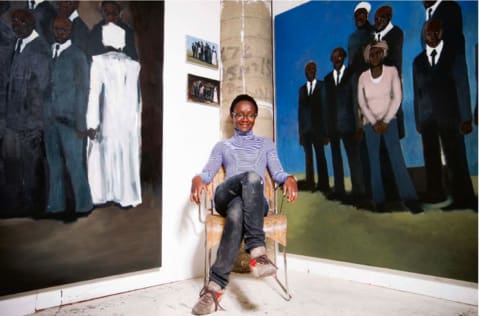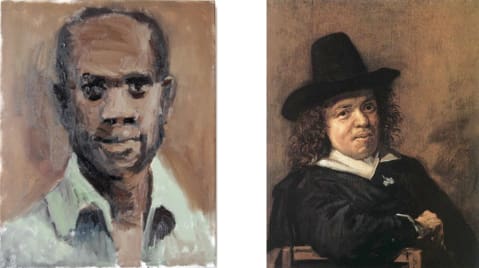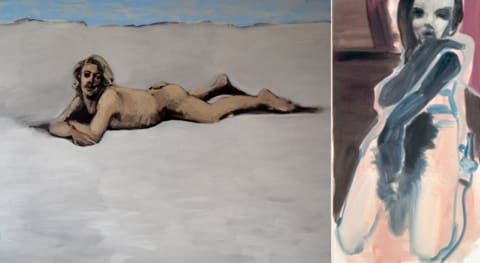When I was a Master's student at Christie's Education in 2010, I presented on Lynette Yiadom – Boakye, a fascinating artist who at the time was just emerging in the fine art world. My professors criticized my presentation - claiming I was too focused on the formal aspects of the artist's portrait painting and her mass market appeal, and was not delving into the racial issues present in the work. Although it was eight years ago, I remember that day vividly; and although, I perhaps only skimmed the surface of Lynette's work and its importance, I still want to share my eight year old thoughts with you - at this time this was written she had not reached the secondary market yet - but now, she has. The below was written by me, Alix Greenberg and all images courtesy Jack Shainnman Gallery.
Lynette Yiadom-Boakye, an artist of Ghanaian descent, was born in London, where she now lives and works. She trained at Central St Martins College of Art and Design and the Royal Academies from which she graduated in 2003. I visited her first solo show in New York at the Jack Shainnman Gallery and was immediately struck by her large-scale, beautifully rendered portraits.

If the viability of portrait painting as a contemporary art form was ever in doubt, Lynette Yiadom-Boakye’s canvases of fictional, imagined characters put that suspicion to rest. As well as demonstrating her mastery of the techniques of traditional established European portrait painting, she applies that classical knowledge in a way that gives her work a distinctive edge and resonant freshness. Also, alluding to European portraiture, is her use of oil paint – a historically significant medium. Yet while throughout art history, the faces that gaze out at the viewer are almost exclusively white, her sitters are always black. And, unlike traditional European portraiture, Lynette Yiadom-Boakye never draws directly from life, rather she invents her subjects and paints straight from her own imagination.
Her characteristically dark palettes coupled with the tactility of her brushstrokes predominate over such defunct ideas as true likeness – she leaves her backdrops unspecified like atmospheric vacuums. Such neutrality quells the politics of representation somewhat, with the all-black figures seeming less a case of cultural reclamation than simply matter of fact, and pulls focus towards the rhythmic glances and stares that mass between them. Thus, in pitting the highly rendered portraits against monochrome backdrops, the inner world of each subject is emphasized, leaving the simplified background to the viewer's imagination. Each painting provides a strange, nuanced approach to portraiture, such that the audience is encouraged to construct relationships within the compositions.
Initially, her paintings appear to be simply portraits; however, the paintings actually depict ideas rather than living individuals. The five-feet tall portraits are not intended to capture the essence of a human being, but an embodiment or evocation of a particular mood or theme. Pushing this idea further, is the artist’s nonspecific, abstract titles such as Ambassador, Concrete, and Politics to name a few. Moreover, her loose, sketchy paint handling lends a drawing quality to the works, so the subjects seem animated.
 Lynette Yiadom-Boakye, Concrete, 2010
Lynette Yiadom-Boakye, Concrete, 2010
 Lynette Yiadom-Boakye, Ambassador, 2003
Lynette Yiadom-Boakye, Ambassador, 2003
 Lynette Yiadom-Boakye, Mature/Love Poetry, 2004
Lynette Yiadom-Boakye, Mature/Love Poetry, 2004
One cannot help but make a relationship between the artist’s Ghanaian roots and the figures she paints. I cannot link specific themes or stereotypes; however, the works can reference her roots or ethnicity, even if she does not explicitly make this link. Because of the unspecific backdrops, we can locate these figures anywhere – from New York City to Ghana. I would not say that Lynette Yiadom-Boakye is a Ghanaian artist, but a contemporary artist living a diasporic experience. Intrinsic to contemporary art is that it is a globalized phenomenon. I think this is how Lynette Yiadom-Boakye reflects the spirit of our time – her work can be understood universally – her subjects are everywhere and nowhere –appealing both visually and thematically to a worldwide audience.
Clearly, Lynette Yiadom-Boakye’s formal application references 19th century modernist painting from Manet to Sargent. In her Pas a Cote de N importe Ou, like Manet’s Olympia, the subject’s body as well as his gaze is unabashedly confrontational; modesty is completely absent in these works. Interestingly, Lynette Yiadom-Boakye adds another layer of discomfort, rendering the subject male and black.

Lynette Yiadom-Boakye, Pas a Cote de N importe Ou, 2010; Édouard Manet, Olympia, 1863
Besides the evident formal similarities between Sargent and Lynette Yiadom-Boakye, it is important to note their relationship in terms of identity. A century ago, there was great focus on portraits because the issue of identity was prevalent. The idea of self-representation was important in issues of modernity and the question of how does one begin to stabilize the notion of identity in a culture that is continually shifting. There was a fundamental relationship of identity and modern notions of the self, and the new notions of personality that would replace the character of the time. Personality was shifting according to time, place, and whom you were with. Indeed, Lynette Yiadom-Boakye invokes those issues of modernity in her portraits. As discussed earlier, the idea of globalization informs and forms the constantly in question identity of the diasporic artist.

Lynette Yiadom-Boakye, Any Number of Preoccupations, 2010; John Singer Sargent, John D. Rockefeller, 1917
On a more formal level, she also looks to the scratchiness of Goya and the loose painterly brushstrokes of Frans Hals.

Lynette Yiadom-Boakye, Curlew, 2010; Goya, detail from Two Old Men Eating Soup, 1819-23

Lynette Yiadom-Boakye, A Political Shirt, 2010; Frans Hals, Portrait of Frans Jansz, 1965
In terms of more recent art history, Lynette Yiadom-Boakye looks to the return to narrative figuration in contemporary painting of the 1990s and is among a group of artists who have developed a particular hybrid of realism and conceptualism, such as Karen Kilimnik, Kehinde Wiley, and of course, Marlene Dumas.

Lynette Yiadom-Boakye, Politics, 2005; Karen Kilimnik, Me Getting Ready to Go Out to a Rock Concert with Bernadette in Moscow, 1998

Lynette Yiadom-Boakye, Wrist Action, 2010; Kehinde Wiley, LL Cool J, 2005
Like Kilimnik, Lynette Yiadom-Boakye’s paintings are from her imagination- both have effaced the boundary from life and the imaginary –
And more substantially, Lynette Yiadom-Boakye, like Wiley, elevates once marginalized figures to the scale of history painting. Lynette Yiadom-Boakye’s, like Wiley’s paintings blur the boundaries between traditional and contemporary modes of representation. Their larger than life figures are depicted in a heroic manner, reinserting into the history of figurative representation, men and women usually not seen in museums.
Lynette Yiadom-Boakye’s work as psychological profiles and evocations of particular moods, also relates to Marlene Dumas’ paintings, which explore the human condition as well as psychological and philosophical themes. Like Lynette Yiadom-Boakye, Dumas’ portraits examine the gaze and process of depiction and interpretation.

Lynette Yiadom-Boakye, The Justifying Doctors Note, 2010; Marlene Dumas, Feather Stola, 2000
We can see that in The Justifying Doctors Note, 2010 – the work’s cool palette and simple uncluttered composition lends an air of familiarity to what, on closer inspection, is a rather incongruous scene. The subject, whose crude appearance is at odds with the feminine delicacy of her pose, is not what we might expect. Lynette Yiadom-Boakye invites us to consider what is or is not appropriate in certain social situations.
Like Marlene Dumas, Lynette Yiadom-Boakye aims to circumvent the perceived limitations of painting and how her work problematizes painting, representation and subjectivity in the light of postmodernist concerns. In both of their work painting returns as sign rather than reflection of a pre-given reality and the possibilities of painting are defined in terms opposed to traditional associations.
However, despite all theoretical, conceptual concerns, we must take in to account that painting, particularly oil, above all other media, still has an incredible premium despite all movement outside the tradition. Painting, as we can see from past auction sales this year, is valued greatest in our society – as a commodity that really stands in for excess for market conditions. I think it is important to note that the greater lack of condition issues for oil paintings make the works easier for collectors etc to purchase.
Though Lynette Yiadom-Boakye has not reached the secondary market circuit yet (this was 2010; she has since reached the secondary market), based on her progress, this year alone, I see it developing in her future. Her present value is $10 to 24 thousand- and her last solo show was totally sold out; collectors and institutions purchased her works. Her next solo show will be in November at the studio museum in Harlem. Based on the sold out show, her increasing recognition, and this important museum show – her works will indeed be more desirable and will therefore increase in price.
In addition to her success this year, she has had three solo exhibitions in London and Geneva, and was invited to exhibit at the 2nd International Biennial of Contemporary Art, Seville (2006), and Gwangju Biennale (2008), both organized by the Nigerian-born Power-100 curator Okwui Enwezor. She was also included in Flow, the important survey of emerging African Diaspora artists by New York’s Studio Museum. As well as more conventional spaces, she has exhibited at the Platform For Art show, a group exhibition that was held at London’s Gloucester Road Tube station. Yiadom-Boakye was the 2006 recipient of both the Arts Foundation Award for Painting and the deciBel Award for Visual Arts. Yiadom-Boakye’s work is mentioned in the new book Contemporary African Art Since 1980, ed. Okwui Enwezor. She is included in several collections among them are The Studio Museum in Harlem, NY, Kunsthalle Mannheim, Mannheim, Germany, and the Saatchi Collection, London.
To end on a more critical note, I am concerned that because Lynette Yiadom-Boakye is so marketable, her possible art historical significance may be overlooked, and she will be deemed solely a market-driven artist. Nevertheless, I believe the works do have staying power - they are timeless, visually accessible, easy to hang, and those in the know will appreciate the works’ art historical and cross-sectional relationships.

Lynette Yiadom-Boakye, No Affiliation With Architects, 2010





Leave a comment